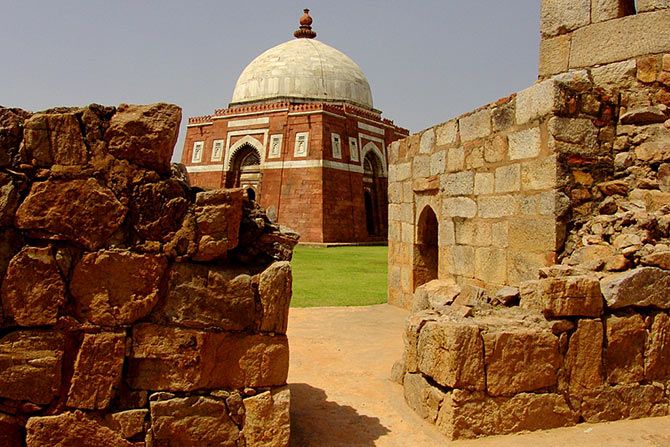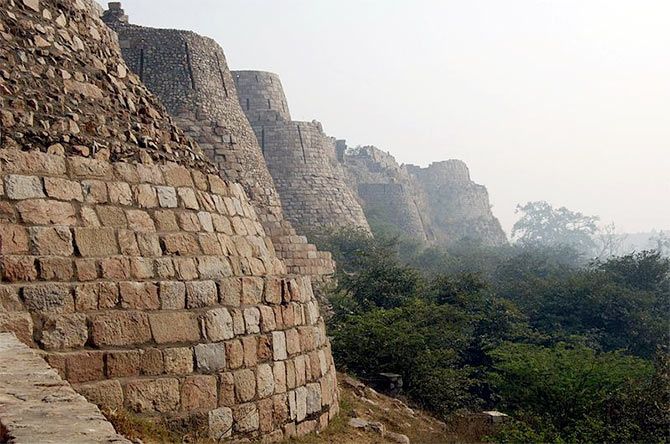Curses, folklore and family feuds swirl around Tughlaqabad Fort

Photograph: Saad Akhtar/Wikimedia Commons
It is a quiet morning. A solitary eagle soars high above the cursed fort, its stone battlements bleached gold as the promontory upon which they rest.
From the tomb across the busy road, I gaze at its ramparts, wondering how something so mammoth could have been erected in barely four years. Behind me is a graceful dome under which the graves of father and son repose.
"Did you know," asks my companion, "many suspect that the son murdered the father to ascend the throne?" And on that interesting note, the storytelling walk through the cursed city of Tughlaqabad commences.
We begin at the end -- the death of the founder of Tughlaqabad, Ghiyasuddin Tughlaq in 1325.

Photograph: Saad Akhtar/Wikimedia Commons
As we stand over his grave, our guide and storyteller Yuveka Singh of Darwesh, a Delhi-based travel and culture studio, narrates how a former slave came to rule, albeit for a short time, the city of Delhi.
And for a while, even though the traffic is loud on the busy Qutub-Badarpur road, I find myself travelling back in time to an uncertain era when the lust for power seemed to be the only permanent aspect of kingly lives.
"It was a period of turmoil for the Tughlaqs," says Singh. "Not only were there hordes of marauding Mongols attacking from the north, there were threats from the neighbouring kingdoms as well."
That explains the massive fortifications, I muse, as we make our way back to the domed tomb to hear how the elder Tughlaq met his end without even seeing his massive fort in Tughlaqabad completed.
Apparently, he died when a wooden platform he was standing on, mysteriously collapsed. Some historians aver that his son, Mohammad bin Tughlaq, had him murdered.
At that time, however, it was widely believed that his death was due to a curse, but more on that later.

Meanwhile, we amble around the well-laid gardens around the high domed tomb (nicely restored and maintained by the Archaeological Survey of India).
Through slanted battlement windows, we see in the distance the city of Adilabad that Mohammad bin Tughlaq founded not long after his father's death.
This too, like Tughlaqabad, is shrouded in the Delhi haze, a haze as thick as the mystery surrounding the two sultans.
Their simple graves lie under a massive, unadorned dome, for it is believed that in the strife-torn era they lived and died in, there was little room for aesthetics and architectural embellishments.
Our introduction to the curse of the Tughlaqs has begun from their deaths, and as we cross the busy road to enter the massive Tughlaqabad fort, it is as if we are moving further back in time as we learn about their lives.

Photograph: ampersandyslexia/Wikimedia Commons
The gateway to the near-impregnable fort is grandiose, boastful even.
While short of aesthetic value, the ramparts are towering (some rising to as high as 98 feet), giving the façade an impregnable air, quite at odds with the ruins within.
I'm reminded of PB Shelley's poem, Ozymandias, which captures the misplaced arrogance of a long gone king whose works had been reduced to ruin by time.
As we walk in the citadel, we come across a series of underground chambers.

Some say this was once a bazaar where vendors sold their wares to the ladies of the palace.
Others surmise that this could have been a granary that held food reserves in case of a long siege. There's a pervading smell of damp ammonia underground, probably from the hundreds of bats that now live here. The steps are uncomfortably high.
"They were built for the fit and healthy -- the old and disabled had no place in that war-driven society," explains Singh. I climb up towards the sun, wondering about the trials and tribulations that Tughlaq and his soldiers must have lived with.
Finally, as we sit on the ramparts of the gigantic citadel, it's time to hear the story of the curse that befell Tughlaqabad.
The story goes that Ghiyasuddin was in a huge hurry to build his fort, but many of his masons left to work for the powerful Sufi Saint, Nizamuddin Chisti. Away on a military expedition, the king was furious when he got word of this and forced the workers in the saint's shrine to complete his own fort first.
The angry saint cursed the king -- "Ya base gujjar, ya rahe ujjar!" (May this city be the abode of nomads or remain barren). One will never know whether he fell victim to the curse or to his son Mohammad bin Tughlaq's lust for the throne, but Ghiyasuddin Tughlaq died in 1325 and Tughlaqabad was abandoned two years later.

Photograph: Saad Akhtar/Wikimedia Commons
The fort has only since been occupied by shepherds and the myriad monkeys, birds and butterflies that flit amongst the thorny wild bushes of Dhatura, the Devil's Snare.
Tughlaqabad Fort stretches across seven-odd kilometres, and we clamber atop the Bijai Mandal, its highest point, to get a birds-eye view.
Thirsty and tired after a morning in the sun, I sit for a while, looking at the melancholy ruins and the stories they hold. The Bijai Mandal was built to announce the king's victories in war, but it seems unlikely that much good news was ever proclaimed from here to the cursed city.
Just then, a news app on my phone returns me to everyday life, alerting me to a controversy over two consummate politicians from either sides of the political fence hugging one another.
I'm struck by a not-too-unhappy thought.
One day, their works and shenanigans too will be dust, just like -- to paraphrase Shelly, the "shattered visage" of Tughlaqabad.
The walk organised by Darwesh costs Rs 500 per person










